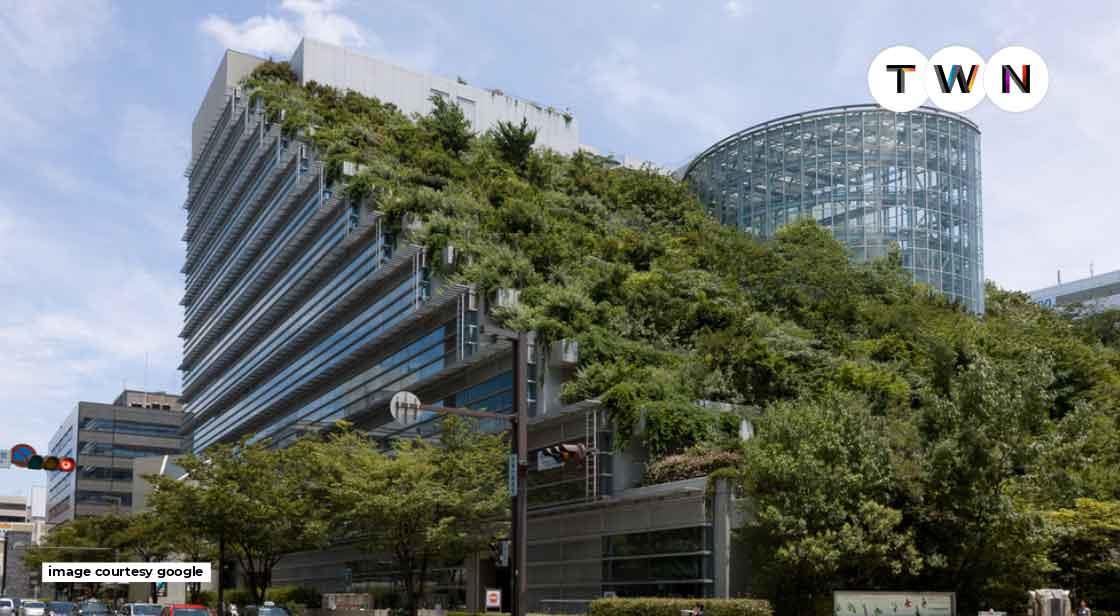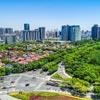How Green Buildings are a Better Way to a Sustainable Lifestyle?

Blog Post
Nowadays age, everyone is contemplating going green. Whether you like it or not, everyone will have to join the green movement at some point. It is because, at our current rate of progress, the earth is simply not sustainable. That means that over time, we will run out of other natural resources that we require to survive. The world has joined this movement by building some amazing green buildings that are working towards a sustainable life for the future. This article is about green buildings, what are they, and some prominent examples that you might have never heard of. Keep reading. #TWN
Many years back, when I was in my early teenage, my teacher told us that if we want to live on this earth for thousands of years, then we must have to protect our planet with everything we have.
We were in the middle of our Environmental Studies class when it suddenly struck me! I wondered why we have to remove trees and forests to build houses and buildings. Why can’t we build houses with trees surrounding them?
Who knew this thought would take shape in reality, and I would be writing a blog about it? This dream is called green buildings, and you will know about it all in this article.
Nowadays age, everyone is contemplating going green. Whether you like it or not, everyone will have to join the green movement at some point. It is because, at our current rate of progress, the earth is simply not sustainable. That means that over time, we will run out of other natural resources that we require to survive.
That is true for some people, which is why there are so many people with an interest in green buildings today. But, what is green building? Let's look at what it is, why you should think about it, and what the goals of a green building are. You will undoubtedly discover that it is something in which you should participate.
What is a green building?
Some people may consider a sustainable and green building to be simply one that has a lower environmental impact than an 'average' building. Others may believe it is due to the type of building and the actual environment of the building.
The ideal green building project would be one that allows you to preserve the majority of the natural environment surrounding the project site while still producing a building that serves a purpose.
The building's construction and operation will prove to be extremely beneficial for all involved, with no disruption to the land, water, resources, or energy in and around the building. It is the true meaning of a green building.
Why Go Green with Sustainable Building?
Why it is critical to go green? Most people will discover that by going green, they can reduce their carbon footprint and truly help the environment. You can go green in a variety of ways, but builders and building workers must also do their part.
If you haven't already started going green, you'll discover that there are a myriad of possible things you can do to get started. You don't have to dive in headfirst, and you can take small steps along the way. Green buildings are designed to have a lower overall environmental impact and human health by doing the following:
- Minimizing trash, emissions, and environmental degradation.
- Making good use of energy, water, and other assets.
- Improving occupant health and productivity.
Advantages of Making a Green Building
Green building benefits can range from environmental to economic to social, with technological advances constantly being developed to supplement current practices in creating greener structures. We can maximize environmental and economic performance by adopting greener practices.
Green construction methods provide the most significant benefits when combined with eco-friendly design and construction. Let’s talk about some of the advantages of green building:
Social Advantages
Improvement in the quality of life
The occupants' quality of life is considered in the design, construction, and operation of green buildings. It aims to improve the health and comfort of building people. According to research, improved indoor air quality (low CO2 and pollutant concentrations, as well as high ventilation rates) can lead to up to an 8% improvement in performance.
Employees in green, well-ventilated office spaces improve their cognitive scores by 101 percent (brain function). Staff members in offices with windows managed to sleep 46 minutes longer per night on average.
Less Stress on Local Infrastructure
Green buildings collaborate with local government agencies and utilities to provide green building and alternative energy training and incentives. They also provide free classes, public forums, and technical training, all of which help to reduce the strain on local infrastructural development.
Existing homes can quickly and cheaply go green, becoming long-term sustainable, non-toxic, zero-water, and zero-energy structures.
Environmental Advantages
Wastage of Energy and Water is Reduced
Sustainable buildings accredited by the Indian Green Building Council (IGBC) save 20–30% on water and 40–50% on energy when compared to conventional buildings in India.
Green buildings with the Green Star certified in Australia have been shown to use 51% less potable water and emit 62% less greenhouse gas emissions than buildings built to meet minimum industry requirements.
Green buildings in South Africa that have earned the Green Star certification have been shown to save somewhere around 20 to 30 percent of potable water per year, as well as 30 to 40 percent of energy and carbon emissions per year when compared to the standard norm. Green buildings with the LEED certification in the United States and other nations have been shown to use 11% less water and 25% less energy than non-green building structures.
It Conserves Natural Resources
When compared to other major emitting sectors, the building sector has the greatest potential for significantly reducing greenhouse gas emissions.
Through objective measurements in building structures such as energy efficiency, fuel switching, and the use of renewable power, this emissions savings potential is estimated to be as much as 84 gigatonnes of CO2 (GtCO2) by 2050.
In order to limit global temperature, to rise to 2°C, the construction sector has the potential to save 50% or more on energy by 2050. (Above pre-industrial levels)
Green Buildings Improve Air & Water Quality
According to research, better indoor air quality with low CO2 and pollutant concentrations and high airflow can lead to up to an 8% improvement in performance.
It Protects the Biodiversity and Ecosystems
Green construction benefits ecosystems by encouraging the efficient use of energy, water, and other assets. It also makes use of renewable energy sources such as solar power. Measures are usually taken to reduce pollution and waste while also allowing for the re-use and recycling of materials. The materials used are non-toxic, morally correct, and long-lasting.
The environment is taken into account during design, construction, and operation, allowing for adaptation to a dynamic environment.
These are some of the advantages and eco-friendly building & the materials used in it
Best Eco-Friendly Building Materials to Use
In the past, we have built with earth bricks, concrete, and wood. They have been and continue to be used in everyday renovation, implying the continued destruction of trees for timber and the mineral extraction of materials to generate cement for binding sand, gravel, and bricks. There are new processes and viable as well as eco-friendly building material options that can be used in building constructions for a better world.
Best Eco- friendly materials for green buildings:
- Cork
- Bamboo
- Precast Concrete Slabs
- Straw bales
- Reclaimed Wood
- Recycled Plastic
- Plant-Based Rigid Foam
- Sheep Wool
- Rammed Earth
- HempCrete
- Ferrock
- Timbercrete
Examples of Green Buildings Around the World
Buildings can be sized in a variety of ways, such as by trying to measure their height, comparing architectural styles, or analyzing their histories. However, in the age of climate change, more focus has been put on a building's "ecofriendly" qualifications, as environmental impact drives design, construction, and function decisions.
Let’s take a look at some of the best green architectures around the world:
One Central Park (Sydney, Australia)
The city that gave you the Sydney Opera House also thinks green, as evidenced by One Central Park.
A park at the base of the building literally continues up the structure, with vegetation of 250 species of Australian plants and flowers covering One Central Park. They are visually appealing, provide shade for the building, and make an unmistakable statement.
Its hovering gantry, which houses the most luxurious penthouses in the taller tower, is a design marvel. According to Skyscraper.com, it consumes 25% less energy than a typical construction of its size.
Opened: 2014
Use: Residential
Design: Ateliers Jean Nouvel with PTW Architects
Vancouver Convention Centre West (Vancouver, Canada)
On the roof of the Vancouver Convention Centre West, the very first building of its kind to receive a dual LEED (Leadership in Energy and Environmental Design) platinum designation, exciting things are happening.
So, what's the big deal? To begin, four hives of European honey bees have been assembled to fertilize the roof's plants and grasses, which helps reduce heat buildup in summer and retain heat in winter. Furthermore, the sloping shape of the roof aids in water drainage and seed distribution.
However, not all of the action takes place on the roof. Some of the projects are built on piles (columns) over the water to support a marine ecosystem that includes native crabs, salmon, and shellfish.
Opened: 2009
Use: Trade shows, conventions, events
Design: LMN Architects
Shanghai Tower (Shanghai, China)
Shanghai Tower, the world's second-tallest tower at 2,073 feet, is both an architectural marvel and a sustainable one.
A clear second skin coated around the building produces a safety cushion of captured air that serves as natural convection, lowering energy costs, and 270 wind turbines integrated into the facade power the building's exterior lights.
The tower uses significantly less energy than other high rises and has a platinum LEED certification as a result of measures like these.
Opened: 2015
Use: Offices, hotels, and retail
Design: Gensler
Copen Hill (Copenhagen, Denmark)
CopenHill, also known as Amager Bakke, maybe the greatest mixed-use development.
It's a power plant that continues to burn waste to generate electricity, as well as a sports complex where you can climb one of the world's tallest climbing skyscrapers. The most spectacular feature, however, is an artificial ski and snowboard slope.
According to Architect Magazine, 440,000 tonnes of waste are converted each year by the blast furnace, steam, and turbines into clean power and heating for 150,000 nearby homes.
Opened: 2017
Use: Power plant, sports facility
Design: Bjarke Ingels Group (BIG)
Marco Polo Tower (Hamburg, Germany)
Marco Polo Tower in Hamburg, like its trailblazing namesake, went where few structures had gone previously.
Around an axis, each floor of the apartment complex is rotated a few degrees away from the one below. This enables recessed facades that shield residents from direct sunlight and eliminates the need for electrical climate control.
Other environmentally-friendly features include a heating element on the roof that converts warm air into a cooling system and natural ventilation, which allows residents to sleep soundly without being disturbed by outside noise, according to Behnisch.
Opened: 2010
Use: Residential
Design: Behnisch Architekten
Bosco Verticale (Milan, Italy)
Architect Stefano Boeri created these deluxe sky apartments with plenty of space for large, full-grown trees as well as a variety of native plants and shrubs. According to Skyscrapercenter.com, the result is "one of the most focused living green facades ever realized."
All of this greenery contributes to better air quality in Bosco Verticale and throughout the city.
Opened: 2014
Use: Residential
Design: Boeri Studio
ACROS Prefectural International Hall (Fukuoka, Japan)
Fukuoka, in southern Japan, was an early adopter of the green architecture movement with ACROS.
One side appears to be a regular commercial structure, while the other appears to be something directly from your Hanging Gardens of Babylon fiction. According to Metaefficient.com, it has a series of 15 garden patios that reach up to about 197 feet. The project arose from a combination of limited options and ingenuity. Fukuoka residents were outraged at the loss of their last public green space in the city center, so architect Emilio Ambasz devised a solution by trying to bring the public green space upward.
The roofs not only look beautiful, but they also help to keep the building cool and provide a habitat for insects and birds.
Opened: 1995
Use: Mixed used, including a concert hall
Design: Emilio Ambasz and Associates
PARKROYAL Collection Pickering (Singapore)
PARKROYAL Collection Pickering is clearly inspired by Singapore's tropical environment. The architecture is inspired by terraformed rice paddies, and innumerable sky gardens have been incorporated into the building's facade.
They provide lush greenery, such as palm trees, to public places and guest room balconies. These have a natural cooling effect as well.
Crevasses, waterfalls, and gullies were also incorporated into the design by WOHA. These features are self-sustaining, utilizing Singapore's high rainfall to water all of those plants via a drip system.
Opened: 2013
Use: Hotel
Design: WOHA Architects
Conclusions
These are some of the marvelous green buildings that use some eco-friendly building materials to ensure that they can keep the environment safe and prevent further deterioration. These buildings have taken upon themselves the responsibility of cleaning our air and water and reducing our energy wastage quotient.
You May Like
EDITOR’S CHOICE












